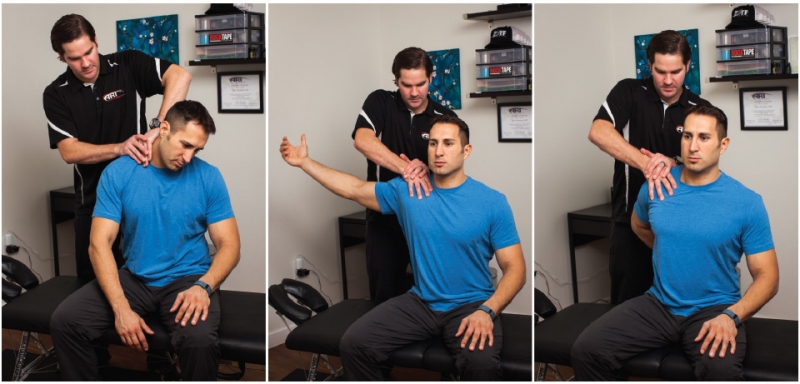
Active Release Technique (ART) is a new and extremely effective approach to treating soft tissue injuries and the resulting pain. It is a patented method of treatment developed by Dr. Michael Leahy and is utilized by more than 3500 certified providers, including chiropractors, physical therapists, medical doctors, and athletic trainers worldwide. The technique is very popular with professional athletes and teams and is used regularly by amateur and professional athletes alike, not only to help with recovery from injuries, but also for improving their athletic performance.
Acute trauma or overuse, sometimes referred to as Repetitive Strain Injury (RSI), are generally the common causes of insult to the soft tissue (muscles, ligaments, tendons, nerves, joint capsules, fascia, etc.). Many of the routine daily activities performed at work or home or while playing sports can result in accumulative injuries to soft tissues. Some common examples of these activities/conditions are:
- Typing, keyboarding or repeated use of a mouse (Carpal Tunnel Syndrome)
- Running/Jogging (Shin Splints, Plantar Fasciitis, Knee & Hip pain, Tendonitis)
- Poor Posture (Tension Headaches, Back pain, Neck pain, Arm & Leg pain)
- Prolonged standing (Heel Pain, Leg Pain, Thigh And Back Pain)
- Prolonged sitting (Buttock And Lower Back Pain, Priformis Syndrome)
- Repetitive wrist/forearm flexion/extension/rotation (Tennis Elbow, Golfer’s Elbow)
- Repetitive & prolonged shoulder rotation (Swimmer’s Shoulder, Rotator Cuff Tears)
- Repetitive bending & lifting (Low Back Pain, Sciatica, Muscle Strain)
- Sleeping on the stomach (Neck pain, Upper Back Pain, Cervicobrachial Syndrome)
- All athletic activities can result in RSI’s (Tendonitis, Sprains/Strains, Myofascitis)
- And many other biomechanical injuries as well
These injuries will result in a series of physiological responses:
- Inflammation
- Repair
- Remodeling
- Maturation
INFLAMMATION
The initial physiological response by the body is inflammation in the affected area. During this phase the circulation and accumulation of fluids within the injured tissue is increased as the body begins to mitigate the damage and remove toxins form the site of injury. The inflammation will lead to increased tension and internal pressure within the injured tissue and the surrounding structures.
REPAIR
In an attempt to heal the injury and stabilize the area, the body will begin the repair process. Fibroblasts begin to create fibrous structures (scar tissue). This generally consists of laying down of fibrotic scar tissue, which form adhesions in and around the injured structures. This scar tissue is generally a lower grade of tissue than the original one and is both functionally and structurally deficient, lacking elasticity and limiting proper circulation and function. As circulation is reduced, tissue hypoxia develops.
REMODELING & MATURATION
During the final 2 phases the body is simply attempting to organize and orient the newly formed fibers so as to restore the injured tissue closer to its natural state. Regretably, the body does a less than adequate job in repairing the effected tissue. The end result is a tougher, less elastic, shortened and therefore weakened tissue, which causes restriction of motion between muscle layers as well as nerves. For the athlete, this means poorer performance, limited range of motion and a greater likelyhood of re-injurying the structure. For the general public and athlete both, this means pain and discomfort at the site of injury; or in the case of peripheral nerve entrapments which are commonly caused after such injuries, pain, numbness and tingling radiating into the arms or legs. The resulting pain typically will start a process of compensation, which will begin affecting other tissues and structures in that kinetic chain.
HOW DOES ART WORK?
ART is a form of Manual Therapy. The practitioner uses their hands to Iocate and treat the injured soft tissue. ART can greatly improve the healing powers of the body. The body is now much more efficient during the process of repair, remodeling, and, maturation. Clinical findings indicate that mechanical loading techniques such as ART help produce increased wound healing along the lines of the injured tissue. As a result the healed structure is not only stronger and more resistant to future injury, but it also has improved functionality. 
According to the latest research, Immobilization or bracing which is commonly used after traumatic injuries results in a prolonged healing time as well as a weaker healed tissue. Contrary to the above approach, ART combines both passive and active Range of Movement in its treatment protocols. Its specific approach allows for differentiation between various structures, thereby allowing the practitioner to locate and treat the correct structure. Combining the manual loading technique with the proper ROM and the specificity of locating and treating the correct anatomical structure allows for the break up of fibrotic tissues and their proper realignment during the healing cycle. ART provides very specific treatment protocols for over 300 muscular injuries and 100 peripheral nerve entrapments as well as many tendonous and ligamentous injuries. This is what sets ART apart from all other soft tissue techniques and has caused many world class amatuer athletes and professional athletes to turn to this method of treatment for help.
CLINICAL STUDIES
https://www.ncbi.nlm.nih.gov/pmc/articles/PMC4563290/
http://www.jptrs.org/journal/view.html?volume=2&number=1&spage=27
https://healthpsych.psy.vanderbilt.edu/2008/ART.htm
